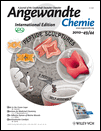Inside Cover: Enantioselective Synthesis of Amines: General, Efficient Iron-Catalyzed Asymmetric Transfer Hydrogenation of Imines (Angew. Chem. Int. Ed. 44/2010)
Graphical Abstract
Although iron is one of the most abundant metals, its application to catalysis is still in its infancy. In their Communication on page 8121 ff., M. Beller and co-workers present the first iron-catalyzed asymmetric transfer hydrogenation of imines. Iron carbonyl complexes in the presence of a tetradentate P2N2 ligand catalyze the reduction of N-diphenylphosphinylimines with high enantioselectivity (99 %) and good yields (98 %).





